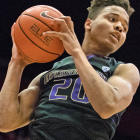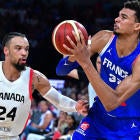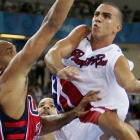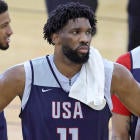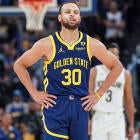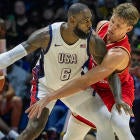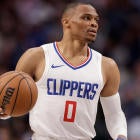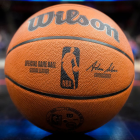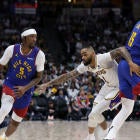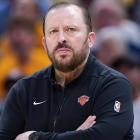Let's say this summer, your team could acquire any player in the draft, free agency (for market value), or trade (for projected market value). Imagine there is a white board of all players teams could hope to acquire. They could trade for the No.1 pick or Paul George or sign Gordon Hayward or any player available through free agency, the draft or via trade. Who do you go after? Here's a ranking of those players, factoring all factors, from skillset, to contract, to timing, to potential, to cost.
1. Paul George | SF | Indiana Pacers
George is a bona fide superstar and by all accounts is available for talks with the Pacers. Larry Bird's departure only increased rumors the Pacers know they'll lose him next summer in free agency and have to pursue a deal. That factor, having to trade to acquire George with no way to be 100 percent sure he'll re-sign certainly makes it tough to decide between him and presumptive No. 1 draft choice Markelle Fultz, but George is the kind of player you simply do not turn down.
George is 27, an All-Star who defends at a high level, can score and can be effective off-ball as well. This sets him apart from the rest of this list; you can plug him into any system. Run an iso-heavy offense? He can carry a team. How about a high-ball-movement motion offense where he needs to catch and shoot? He can do that, too.
He's a fierce competitor and comfortable being the face of a franchise. The guy broke his leg in horrifying fashion and yet it's fair to say he has no injury issues (played 75 games this past season). He's in his prime for at least another five years, and doesn't need specific personnel around him to be successful.
The Celtics don't need to, or have to trade the No.1 overall pick for George (also could trade other assets, or try and sign him next summer). But if they did, no one would see it as a bad deal. If the Pacers were to deal him for the No.1 pick, they would need something of value in return. That's how good George is.
Ignoring realism of acquisition, and with understanding it varies DRASTICALLY depending on which team, what player has more VALUE right now?
— Hardwood Paroxysm (@HPbasketball) May 25, 2017
2. Markelle Fultz | PG | Washington Huskies (NBA Draft)
Choosing between Fultz and Jimmy Butler is just as fascinating. If you want George or Butler, it's to compete for championships immediately. You want Fultz for the future. You get a No.1 overall pick projected as a potentially elite player on a rookie deal for four years, then a max extension for another five. That's nine years with Fultz as a franchise guy. That comes with uncertainty because the draft is a crap shoot. But so is the potential. What if Fultz is a top-five player in five years?
Butler already is an All-Star. Fultz is the Mystery Box problem, and it speaks to where all the draft prospects are in this list. This list changes after the draft. When you're a prospect, you're potential ability. Your weaknesses are things that may not translate in the NBA or that can be overcome. When that draftee becomes an NBA player, injuries and weaknesses, hang-ups are for real.
Fultz may never be more valuable than he is now and is here because he's a good enough shooter to pair with a ball-dominant star and talented enough to run an offense. He's strong, athletic and on a rookie deal for years.
3. Jimmy Butler | SF | Chicago Bulls
Butler may be underrated and overrated at the same time. He's a vicious defender; he'll body you at half court and make your life a living hell with his speed, strength and tenacity. He's one of the league's best tough-shot makers. And without question he had a better season than George this past season. On top of that, he's signed to a deal worth less than $20 million per seasons through 2020. A club could get Butler at a less-than-superstar-max value through the rest of the decade, and in his prime. That's tremendous value.
Most think that Butler has more value than Fultz:
Ignore realism of acquisition. Regardless of team's situation, what player has more VALUE right now?
— Hardwood Paroxysm (@HPbasketball) May 25, 2017
But Butler is not plug-and-play. Fultz could very well never be as good as Butler. But Butler is ball dominant and low efficiency. He grinds possessions down and got frustrated with younger teammates last season. George can plug into any offense, and Fultz can run next to a ball-dominant guard like Isaiah Thomas. Butler needs the right pieces around him. You can't ask him to be Kevin Love or Klay Thompson. So while Butler is a phenomenal talent worth selling the farm to land, he has limitations.
4. Gordon Hayward | SF | Utah Jazz
Hayward was a player people scoffed at getting a max deal the last time he was up in restricted free agency. Now he's the belle of the free agency ball. He is a gifted scorer who can make plays for others, rebound and defend at a high-level. His shooting efficiency and production per 100 possessions was on par with Kawhi Leonard, an MVP candidate last season. He comes with no injury or locker room red flags. He just competes.
Hayward is not a guy a club can build a championship around as its best player, but can help get you there if you're looking at a 3-star team, and he can cover for deficiencies of others. You're looking at a veteran max for him this summer, but he's worth it.
No rookie this time, ignore realism/context, which player has more VALUE right now factoring EVERYTHING?
— Hardwood Paroxysm (@HPbasketball) May 25, 2017
5. Blake Griffin | PF | Los Angeles Clippers
There are red flags, to be sure. You're giving a max contract to a player with a significant injury history, whose jumper has improved but never has been deadly, who punched a beloved equipment manager and broke his hand doing it, and who has seen his athleticism slide.
But Griffin's still incredible and injury histories aren't linear. Griffin's season has ended the past two years with injury. But if he goes through a three-year stretch without a major one, you wouldn't be surprised. And he does everything: Scores, rebounds and is a remarkably underrated passer. He shoots well enough to keep the defense honest on the pick and pop. He produces, and does so efficiently. There are warning signs, but you also might be getting five great years.
6. Chris Paul | PG | Los Angeles Clippers
The Point God feels low on this list, but we can't ignore age and contract. Paying more than $30 million for a 36-year-old (unless it's LeBron James) is just never a situation you want to be in, even if he's a Hall of Famer. Paul's also a pain to deal with because of how intense he is. He's smart, and makes everyone better, but if your system and organization isn't airtight (hello. Spurs) then he comes with a cost that goes beyond the contract.
Paul does't make sense for a lot of teams. You have to be in a position to win now and willing to pay him. But he's still one of the all-time greats at his position, still putting in efficient, productive seasons and often looks like the best player on the floor. That's valuable, no matter what the future holds.
7. Lonzo Ball | PG | UCLA Bruins (NBA Draft)
Ball may not even go No. 2 in the draft because there are arguments for others, but he still has more momentum and a higher upside than the challengers for that spot. Ball is the most likely rookie on this list to wind up lower than his ranking. He's not a great defender, and his jump shot is somewhere between an area of concern and a flaming warning flag. He comes with his obnoxious father who is almost certain to make life difficult for the GM and coach.
But he also has unreal feel for the game and passing ability, and while that jumper is a concern for some, there also are reasons to believe in it. He hasn't finished against contact well but that's something that could change in the NBA with training.
Trying to figure out what Ball will be is difficult. His ceiling is impossible to quantify because his game relies upon non-traditional, unconventional characteristics. He could be special, he could be good-not-great. But that potential, on a rookie contract, still lands him this high. But unlike Fultz, there aren't 30 teams that would take him.
Ignore realism and team context. Which player has more VALUE at THIS moment?
— Hardwood Paroxysm (@HPbasketball) May 25, 2017
8. Kyle Lowry | PG | Toronto Raptors
This feels disrespectful because Lowry is an All-Star. He's one of the 10 best in the East. He's a great shooter, finisher and passer. He's more well-rounded than Ball and maybe more than Ball ever will be. He's worth the max he will get this summer.
But he is getting the max, and is only a year younger than Paul. It's a lot of money for a guy who will be past his prime by the finish of the contract. Lowry's playoff failures have to give teams pause, and he's not quite the defender Paul is, nor the passer Ball projects to be (though he's undeniably a better scorer).
Lowry's notoriously recalcitrant personality should not be the focal point on a rebuilding team, even as a bedrock (pay attention, Sixers). But in a ready-to-win-now situation, he probably rates ahead of Ball, even with the price and years. It's awfully close, though.
9. Serge Ibaka | PF | Toronto Raptors
Ibaka isn't as good as several of the players after him. You can argue based on talent he's probably 10-12 spots too high. But two things:
- He's plug-and-play. He can play the 4 or the 5, defend either spot, spread the floor or play inside, and doesn't need the ball to be effective.
- He's 28 next season, giving him a longer range of productive seasons for (most likely) less than a max contract.
He doesn't match Ball's upside, but a team gets better with Ibaka, who likely will become a better leader as he mellows with age.
10. Paul Millsap | PF | Atlanta Hawks
He is the opposite of Ibaka. Based on productivity and efficiency, he probably deserves seventh. But Millsap is 31 will land a max contract. That's a ton of money for a guy who is very unlikely to put in better seasons than he's already had. How many more great years of Millsap are you getting? You're probably still getting several good ones, and you can win next year with him as your third-best player.
His efficiency and rebounding dipped this past season, warning signs when compared to guys above him.
11. Josh Jackson | SF | Kansas Jayhawks (NBA Draft)
Jackson's ceiling is probably similar to Hayward, but he has to make up a big gap to make up to get there. He has passing skills, but he's just not nearly the threat with the ball Hayward was coming out of college. He is very strong defensively and could very well end up the best player in this draft.
But his shot is a monster question mark, and for wings, that can spell doom. He got his points at Kansas by finding them in couch cushions, in transition and on offensive rebounds. When his athleticism is matched in the NBA, that gets much tougher.
Ignore realism and team context, and factoring EVERYTHING you can think of, just overall, which player has more VALUE at THIS moment?
— Hardwood Paroxysm (@HPbasketball) May 25, 2017
12. Andre Drummond | C | Detroit Pistons
Drummond is a surprise on this list on two levels: Being on it at all as being trade targeted, and being this low. Two years ago, he he looked like a top-five center but this past season, he's slid big time. Things got so bad between Drummond and Stan Van Gundy that trade rumors popped up though the Pistons have been adamant in quelling them.
But if he is available, he's still a freak of nature who can rebound and dunk on pick and rolls, and whose defensive upside is yet to be tapped. If he gets there on that end, he would be dominant.
That said, he's also a guy who completely vanishes for games, and even weeks at a time, and it no longer seems just like youthful inconsistency but an actual flaw in competitive focus.
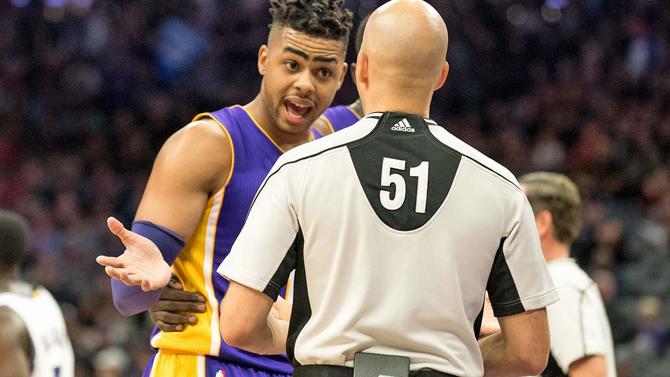
13. D'Angelo Russell | PG | Los Angeles Lakers
The Lakers are rumored to at least be feeling out deals for Russell with the team zeroing in on Ball. Russell's ranking here could look look ridiculous in a few years -- and either way. He could be a prolific scorer who shapes the league or a malcontent who clashes with every teammate and coach.
Russell has superstar potential, but hasn't put together a long enough streak to believe he's on that path.
14. Jayson Tatum | SF | Duke Blue Devils (NBA Draft)
Tatum's either a sleeper or underrated. This is not a he-is-who-he-is kind of prospect. His profile is a smaller cross between Tobias Harris and Griffin. He's got great wingspan and range, but there are questions:
- Is he going to be any good defensively?
- Will he be a good passer? Can he reliably hit NBA 3s?
- Is his lack of explosiveness going to limit his finishing ability?
He may wind up as a small ball David West in a pick-and-pop offense, or a drifter who never establishes an identity. But on a rookie deal with his offensive upside, it's easy to buy in.
Ignore realism, context, just factor all known factors OVERALL, which player has more VALUE at THIS moment?
— Hardwood Paroxysm (@HPbasketball) May 25, 2017
15. Carmelo Anthony | SF | New York Knicks
This is brutal. He's a superstar, a 10-time All-Star and one of the best one-on-one scorers we've seen.
How do you build around him? A team would pay $50 million over two more seasons for a 32-year-old ball-dominant player who needs an offense designed around him, because he's not going to adjust. He doesn't play defense and says he prefers to lead by example.
Would the Cleveland Cavaliers rather have Melo than Tatum? Probably, though a youth movement would do their depth good. What about every mid-level to bad team? They'd rather have Tatum or Jackson's upside, or Millsap's consistency and defense.
Anthony's not bad. He's not a drain. He's just expensive, and there's a reason the Knicks didn't have teams knocking down their door at the deadline, regardless of his no-trade-clause.
16. Eric Bledsoe | PG | Phoenix Suns
This ranking comes down to injuries. Bledsoe is only 27, in his prime with terrific athleticism, playmaking and shooting ability. But injuries have crushed him time and time again, to the point it's hard to believe he'll be healthy. He also hasn't been able to lead the Suns to a plus-.500 record, despite having some talent around him through the years, young as it may have been.
But Bledsoe can help a team win. If he stays healthy and hits his peak, look out. The Suns may not make him available because their draft position doesn't allow them to target a certifiable upgrade.
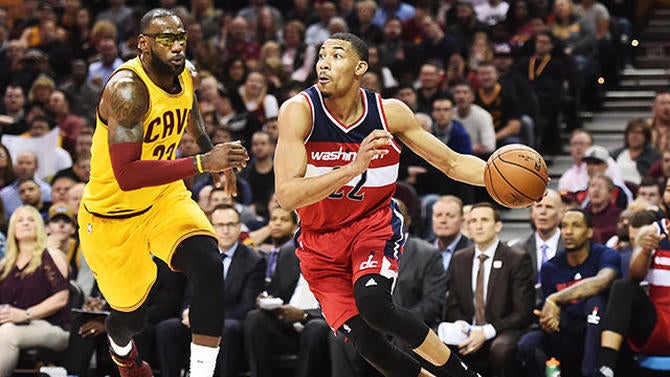
17. Otto Porter | SF | Washington Wizards
Some will scoff at this one, especially with the talented prospects behind him. But Porter is a good-to-great defender coming off his rookie deal who shot 52 percent overall and 43 percent from 3-point range this past season. He is the very model of the modern combo-forward you need -- not want, need -- in today's NBA. He's only this low because he's a role player who will demand a max contract.
18. De'Aaron Fox | PG | Kentucky Wildcats (NBA Draft)
I have a draft motto. When in doubt, draft a John-Calipari-recruited guard. It works out more often than not. But Fox also is a point guard who can't shoot, and we've seen so many of those players fail to translate ability to wins. His defense, passing and athleticism are terrific. He's going to help a team. But it's what he does not bring to the table that could be a concern in today's perimeter-obsessed NBA.
Ignore realism and context, just factor all known factors OVEALL, which player has more VALUE at THIS moment?
— Hardwood Paroxysm (@HPbasketball) May 25, 2017
19. Jonathan Isaac | SF | Florida State Seminoles (NBA Draft)
If Fox is can't-miss guy without the requisite skills for the league today, isaac is the opposite. A high-risk, high-reward prospect who could wind up being the second- or third-best player in the draft because of today NBA.
He can shoot and block shots. That combination, specifically, is what a lot of teams are seeking. The only reason he's not a top-10 guy on this list is an injury history that raises durability concerns, and the fact he's unlikely to be a player you look to as a primary offensive option.
20. Malik Monk | PG | Kentucky Wildcats (NBA Draft)
If Monk adds things to his game, specifically with the ball in his hands, look out. He has underrated passing ability. He's not going to make great reads, but he can execute necessary functions. However, he's mostly a shooter. Do you want a guy who is most likely a gunner, but could be a take-over-the-game guy, or the safe, reliable option of a veteran point guard in Jrue Holiday?
Monk's shooting makes him more desirable for most contenders than an overpaid starting point guard in Holiday, and the lottery squads will want to see if he can become more than a shooter.
Ignore realism/context, just factor all known factors OVERALL, which player has more VALUE at THIS moment right now?
— Hardwood Paroxysm (@HPbasketball) May 25, 2017
21. Jrue Holiday | PG | New Orleans Pelicans
There's nothing Holiday is bad at. Nothing. He can score, shoot, rebound, pass, defend and run an offense. He's low maintenance and high-motor. His career-scuttling injury concerns haven't been so for a year and a half.
At 27 next season, he's not going to make major leaps, but he's hitting his prime. He's also going to command a max salary for a player who's not among the top 10 at his position.
22. Dennis Smith Jr. | PG | NC State Wolfpack (NBA Draft)
Smith could go as high as No. 4 overall. He can get to the rim, is a great passer and will be a good floor general. He's 6-foot-3, but it feels like he plays smaller than that. He also suffered an ACL tear in college and is going to be 20 next season. His floor is probably "veteran reserve," but it's hard to see his ceiling on par with the guys above him.
23. Taj Gibson | PF | Oklahoma City Thunder
This guy will help a team win. But other guys can do what he does, you just have to pay more than one guy to get them done. He's selfless and tough as nails. But he's also 31 and undersized.
24. JJ Redick | SG | Los Angeles Clippers
Another guy who will help you win. Redick still is an elite shooter, and while his defense slid a bit this past season, he's still capable of being great in the right matchup. But he's on the back side of 30 and looking for a big-money deal. It's a large investment for a role player.
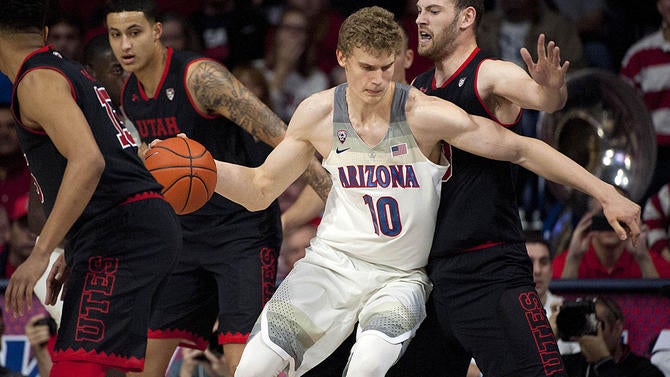
25. Lauri Markkanen | PF | Arizona Wildcats (NBA Draft)
Great fit for the modern NBA with his size, athleticism and range, but guys like this also can look like stiffs at the next level. He's a great candidate for a reach pick, but his actual value isn't as high, because even though stretch 5s become more valuable every day, you don't need one to compete.
26. George Hill | PG | Utah Jazz
Would be in the top-15, but he's a free agent who is over 30, coming off his worst injury season of his career, looking for something close to a max deal. Like Holiday, why would a club pay top dollar for an aging player who isn't top ten at his position?
27. Dion Waiters | SG | Miami Heat
Don't laugh. He learned how to win in OKC, stepped up big time for Miami and continues to mature and improve. He's a guy who legitimately helps a team, and given the deal he took this past season, he might be landed at a discount.
28. Justin Jackson | SF | North Carolina Tar Heels (NBA Draft)
Probably just an NBA wing, but worth taking a 3-and-D flyer on.
29. Danilo Gallinari | SF | Denver Nuggets
Gallo is going to command a lot of money on the market and hasn't been the same since an ACL injury and subsequent problems with surgery issues. His upside is low, and his impact may vary. But he's also capable of being absolutely great on any given night, and could wind up being one of the better signings of the summer if the right fit (and price) is found.
30. Nerlens Noel | PF | Dallas Mavericks
Going to cost a max deal off his rookie deal, and he comes with some maturity question marks. But Noel is an elite shot blocker and could absolutely transform a team's defense while finishing alley-oops. Expensive for a guy who hasn't shown superstar ability, but he's also still got a world of upside, especially defensively.









